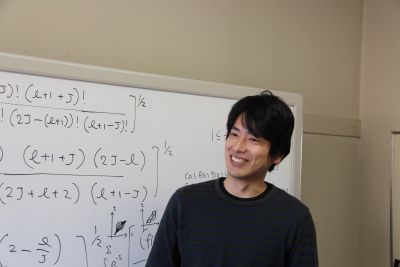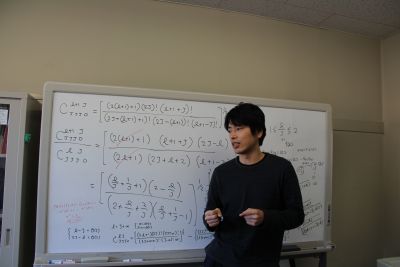TSUKUBA FUTURE
#053 Cosmic Cat's Cradles
Assistant Professor ISHIKI Goro, Faculty of Pure and Applied Sciences
What is the universe made of? What was there before the Big Bang? There are probably a lot of people who entertain such questions. Books that explain topics such as the theory of relativity or black holes are certainly selling well. While this may be the heyday of Japanese research on the neutrino, with the recent Nobel Prize in Physics being awarded to a Japanese researcher, there is still quite a bit we do not yet know about elementary particles like the neutrino. That is where string theory comes in, which attempts to provide a unified explanation of the underlying forces behind the elementary particles.
It is likely that you have heard the term "string theory." This theory basically states that the universe is made up of incredibly tiny vibrating "strings." The first question you might ask would be "Won't all those strings get tangled up?" Prof. Ishiki, who is himself a string theory researcher, has been kind enough to respond to the natural skepticism and questions that have arisen around this topic.
The aim of string theory is to provide a unified explanation for the movements of elementary particles. Einstein's general theory of relativity was a magnificent supplement to Newtonian physics. Relativity offered good explanations of the action of extreme gravitational forces and movement approaching the speed of light. However, the theory of relativity does not apply to the microscopic world of elementary particles. There, we enter the realm of quantum mechanics. Oddly enough, quantum mechanics is unable to provide an explanation for gravity. According to Prof. Ishiki, when we try to perform calculations on gravity using quantum mechanics, those calculations result in answers of infinity. When we investigate deeply into matter, we can find that it is composed of upwards of 20 types of elementary particles. Those elementary particles interact with one another in four ways: via gravity, electromagnetism, weak nuclear forces, and strong nuclear forces. With the exception of gravity, the remaining three interactions can be explained with a theory known as "field theory." By performing calculations on elementary particles with the assumption that they are "point particles" that have no size, a great many phenomena can be explained. With Newtonian mechanics, if we know the initial state of an object in motion, we can know all about its motion from start to finish. However, when it comes to elementary particles, according to the famous "uncertainty principle," motion from point A to point B can be considered to be infinite. With quantum mechanics, calculations can be made by adding up all of the orbits that can be described by a point particle (that is to say, all its lines). We can even go as far as saying that this method can be used to explain the three types of interactions. However, quantum mechanics cannot describe the interactions of gravity. Therefore, according to Prof. Ishiki, string theory constitutes a way of thinking that looks at elementary point particles as one-dimensional "strings," where surfaces rather than lines are added up. Assuming simple conditions, we know that this method is capable of describing all four types of interactions.
While we can feel like we understand it somewhat, there is still something about string theory that is hard to grasp. We live in a three-dimensional world, one that has length, width, and depth. If we add in one more axis for time, our world becomes four-dimensional. Interestingly enough, string theory makes the hypothesis that (with time included), the world has ten dimensions. Any lower than that number of dimensions and mathematical inconsistencies start to occur, so according to Prof. Ishiki, string theory needs ten dimensions at the very least. So, if we take away time for now, that leaves a nine-dimensional space including the three-dimensional space we live in (and which we are aware of). So how in the world are they related? As we talked about above, string theory considers nine fundamental spatial dimensions to exist. Of those, string theory puts forth the idea that six of the dimensions are small and curled up together due to a special type of motion, leaving only the remaining three dimensions that we can see. Prof. Ishiki talked about the following example. An ant walking across the surface of a sphere floating in the air might perceive the world as two-dimensional. If that sphere were noticeably stretched out as if it were a thin wire, the ant walking on its surface may be aware of the world as having only one dimension. But what would an actual multi-dimensional world be like?


There is nothing but a computer, a whiteboard, and a sofa in Prof. Ishiki's lab. It is a place where researchers and graduate students can join together and speak a common language of numbers to come up with precise mathematical expressions.
All things considered, even the idea of just four dimensions can make your head spin, but what about ten? Prof. Ishiki says that as a child, he wondered at the idea of space having three dimensions, and the fact that it was possible to add on the axis of time, which had completely different properties than the other dimensions was equally perplexing. His questions only grew when he started studying coordinate systems in his high school mathematics class. He entered university to study architecture within the engineering department. In his third year of university, he happened across a general guidebook about theoretical physics in a bookstore, and that revitalized his interest in the subject. Prof. Ishiki says that the book was entitled Three Roads to Quantum Gravity, and was written by the physicist Lee Smolin. The book was an explanation of several quantum gravity theories, which intended to unify the theory of relativity with quantum mechanics. One such quantum gravity theory is string theory. Prof. Ishiki soon became engrossed in reading the works of Steven Hawking and other books about string theory, and these books helped to solidify his intentions to study these topics in earnest at the graduate level. In April of 2014, just before he took up his post at the University of Tsukuba, some of Prof. Ishiki's joint research was published in the journal Science. His research partially described how it was possible for gauge theory (a type of field theory) to be equivalent to an advanced type of string theory known as superstring theory. His current research involves his attempts to prove information about several well-known anticipated findings in the world of physics.
Article by Science Communicator at the Office of Public Relations


